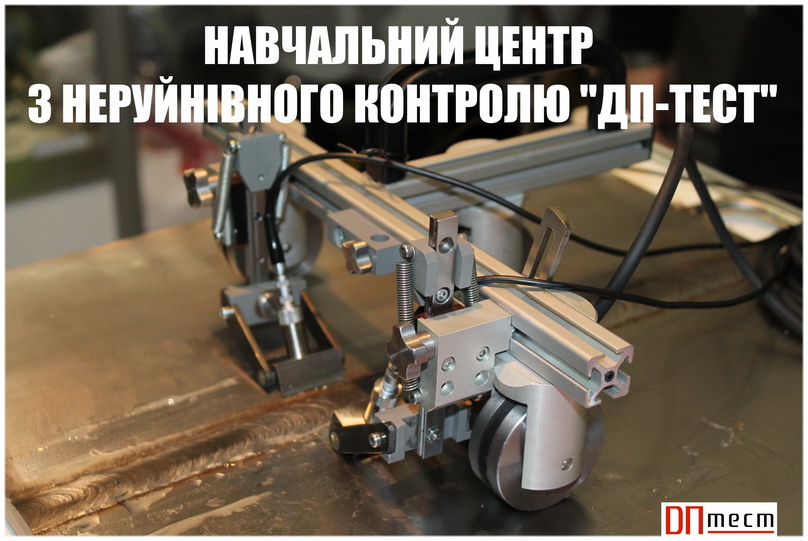Relevance of the topic: Today, in various technical applications in the field of automated non-destructive testing (NDT), the issue of determining the coordinates of defects, various types of material inhomogeneities, etc., which do not meet the quality requirements of the controlled products, is relevant. The use of coordinate information makes it possible to monitor defects, as well as to build B- and C-scans, which contain not only information about defects, but also the coordinates of their location on the surface of the control object (OC). With this approach, according to the obtained data, it is possible to observe the process of the development of defects, and to monitor the appearance of new defects, to conduct additional studies of the detected defects by other NC methods, as well as to perform an assessment of the general condition of the object of control. Solving the issues of NDT automation in many practical tasks requires the use of non-contact methods of registration of coordinate information. Such methods require the use of additional means of information and measurement technology, focused on the use of various physical fields and phenomena - acoustic, optical, etc., and the formation of appropriate information signals that are carriers of coordinate information. In real conditions, such signals are observed against the background of significant noise and interference. Therefore, the study of non-contact methods of coordinate registration of information in systems of automated NDT, which provide reliable and accurate determination of coordinates under conditions of low signal/noise ratio, is an actual direction of development of NDT.
Purpose of the research: The purpose of the dissertation is to develop a non-contact ultrasonic interference-resistant method of two-coordinate registration of the spatial position of the primary transducer on the surface of the control object during eddy current non-destructive testing.
To achieve this goal, the following tasks were set and solved in the work:
– to analyze the modern means of determining the spatial coordinates of the primary transducers in NDT tasks and the coordinate registration methods implemented in them, to investigate the possibility of automating various NDT methods and means due to the registration of sensor positions;
– to develop a new method of registering the coordinates of the position of the sensors using the ultrasonic multi-frequency phase method of determining distances with the elimination of the ambiguity of phase measurements based on the numerical system of residual classes (NSRC);
– to improve the method of eliminating the ambiguity of phase measurements, which is based on the use of the NSRC in order to ensure reliable determination of coordinates at lower values of the signal/noise ratio;
– to develop a method of calibrating the ultrasonic system of two-coordinate information registration according to the speed of sound in order to increase the accuracy of coordinate determination, as well as a method of determining the size of dead zones in which it is impossible to accurately distinguish two adjacent coordinates with a given coordinate determination error;
– to develop software and algorithmic support that implements the proposed methods and techniques for registering the coordinates of the primary transducer.
– the structure of the hardware part of the tool for coordinate registration of the position of NDT sensors was developed, which, due to the use of the correct selection of basic elements, as well as speed calibration, made it possible to reduce the measurement error of the positioning coordinates of NDT sensors.
The object of research: the process of determining the coordinates of transducers in automated NDT systems.
The subject of the research: ultrasonic multi-frequency phase coordinate determination method with disambiguation on the basis of NSRC.
Research methods are based on the use of: methods of technical diagnostics and non-destructive testing; theories of automatic regulation; information and measurement technologies; number theory; mathematical analysis; digital methods of signal processing, namely discrete Hilbert transformation; theory of probabilities and mathematical statistics; computer modeling.
The scientific novelty of the obtained results is as follows:
1. The method of determining the coordinates of the sensor based on two-dimensional trilateration and the ultrasonic multi-frequency phase method of determining distances with the estimation of the full phase shift between the emitted and received signals with the help of the NSRC has been improved, which makes it possible to register the coordinates of the transducer with increased accuracy.
2. A method has been developed to eliminate ambiguity of phase measurements when applying the NSRC, which is based on the reconciliation of the NSRC residuals obtained from the results of phase measurements at all operating frequencies, which makes it possible to eliminate gross errors of restoring the full phase shift at a low signal-to-noise ratio, and, accordingly, to obtain correct the value of the distance between the emitter and the receivers of ultrasonic vibrations.
3. A method of reducing the measurement error of the spatial coordinates of the sensor is proposed, which is based on the additional measurement of the acoustic signal propagation speed, which made it possible to ensure the invariance of the distance measurement results with changes in the meteorological parameters of the environment.
The practical significance of the obtained results is as follows:
1. A technique for determining the coordinates of the primary transducer has been developed, provided that the ultrasonic multi-frequency phase method and the NSRC are used, which are based on the restoration of the complete phase shift of the signals and the elimination of the ambiguity of the phase measurements using the NSRC.
2. The method of applying the NSRC to ensure correct operation in the presence of a low signal/noise ratio has been developed, which is based on the reconciliation of the residuals of the NSRC obtained from the results of phase measurements at all operating frequencies.
3. A technique for determining dead zones has been developed, which is based on the determination of areas within the controlled area of the product, for which it is not possible to distinguish two adjacent coordinates with a given error of their determination.
4. The performed computer computing experiments using the ultrasonic multi-frequency method and NSRC made it possible to work out the software implementation of the algorithm for determining the coordinates of the sensor and to confirm the effectiveness of the proposed method of registration of coordinates.
5. The structure of the hardware part of the tool for coordinate registration of the position of NDT sensors was developed, which, due to the use of the correct selection of basic elements, as well as speed calibration, made it possible to reduce the measurement error of the positioning coordinates of NDT sensors.
Conclusions:
1. As a result of the research, the NSRC method was improved, designed to eliminate the ambiguity of phase measurements when determining distances using the trilateration method. For improvement, the method of matching the residuals of NSRC was used, which is based on established certain rules for rounding off the residuals, which makes it possible to correctly restore the value of the phase shift under the condition of a low signal-to-noise ratio. The proposed method provides reliable recovery of the phase shift with a signal-to-noise ratio of at least 1.1 when using a rectangular contour and at least 2.5 when using a gaussian contour when probing acoustic signals.
2. A new ultrasonic phase method of two-coordinate information registration has been developed, which is designed to determine the position of the sensor during automated non-destructive testing. It is based on the determination of coordinates by the method of trilateration. The distance between the emitter and two receivers of ultrasonic oscillations were determined using the acoustic multi-frequency phase method, and the ambiguity of phase measurements was eliminated based on the use of the NSRC. The proposed method makes it possible to determine the coordinates of the sensor position with an error of ±0.5 mm, which is quite sufficient for its use in eddy current flaw detection.
3. The method of determining dead zones was developed, for the search of which, based on the discrete value of phase measurements, a marginal error of 170 (~0.3 rad) was established, which made it possible to establish that the proposed acoustic coordinate determination system has a dead zone at the beginning of the measuring distance with an area of 1000x80 mm2. Also, the dead zone of the ultrasonic signal receivers with a circular pattern of 1350 with an area of 1000x207.1 mm2 was determined.
4. To reduce the error in determining the coordinates, a system calibration method was developed based on the speed of acoustic waves in the environment. Its application made it possible to reduce the additional error of determining the sensor coordinates in conditions of variation of meteorological parameters to 0.1%.
5. A model experiment was conducted, in which it was assumed that the ultrasonic emitter is combined with the primary transducer of the flaw detector, and two ultrasonic receivers are installed at the ends of the base. Input data: the controlled flat section of the OK has the form of a square with the size of 1x1 m, the coordinate grid of the sensor location was set within the square with a discrete step of 1 mm, the value of the base (the distance between the receivers) was equal to 1 m, the number of operating frequencies was three, the method of determining the coordinates was multi-frequency phase method, the method of eliminating the ambiguity of phase measurements - based on NSRC. The simulation results proved the possibility of practical implementation and use of the proposed methods and techniques when used in eddy current non-destructive testing. Based on the number of phase shift readings per signal period of 16, the system's performance was maintained at a signal/noise ratio>2.
6. The proposed system can be used as an independent means of determining coordinates, or as a subsystem of coordinate registration in means of automated non-destructive control. The small error of coordinate measurement ensures the possibility of using the coordinate registration system for small-aperture sensors -both eddy current and ultrasonic.
7. The structure of the hardware and software tool of the proposed multi-frequency phase system of two-coordinate information registration, based on NSRC, in the systems of the automated eddy-current non-destructive testing was developed and recommendations were given for the selection of the element base for its implementation. It is proposed to use a US40KT-01 emitter with a frequency of up to 40 kHz with a circular directional diagram of 360 deg., a 400EP14D receiver-emitter with a frequency of up to 40 kHz with a circular directional diagram of 135 deg. , and to process phase data and determine coordinates on an ATtiny826 microprocessor.
Research advisor: Y.Kuts









